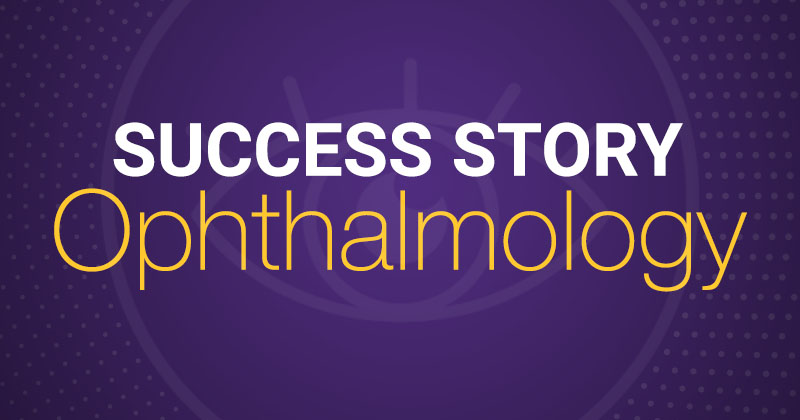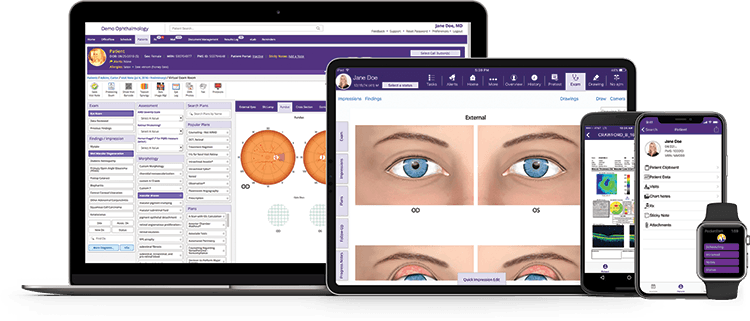Johnson City Eye Clinic and Surgery Center Streamlines Workflows and Saves Time With All-In-One Ophthalmology System

Case Study

Practice Goals
- Implement all-in-one ophthalmology software
- Increase operational efficiencies
- Collect and track MIPS data easily
- Build a collaborative relationship with the software vendor
Key Benefits Experienced
- Streamlined processes and workflows
- Developed long-term support relationship
- Increased provider and staff satisfaction
- Saved time with integrated features
Learn how Johnson City Eye Clinic and Surgery Center prepared and executed a smooth ophthalmology EHR and practice management implementation.

“The ModMed Ophthalmology suite has a beautifully written user interface that has helped streamline our operations, save time, and improve our documentation.”
‒ Tony Turner, Chief Information Officer
Johnson City Eye Clinic and Surgery Center
Johnson City Eye Clinic and Surgery Center was established in 1942. Eight physicians and over one hundred ophthalmic staff members serve patients in Tennessee, Virginia, Kentucky and North Carolina. In addition to comprehensive eye care, their doctors specialize in cataract surgeries, the treatment of glaucoma, macular degeneration, retinal disease, cosmetic and reconstructive surgeries, and pediatric ophthalmology. They also provide same-day procedures in their surgery center facility.
The practice realized that their legacy EHR vendor was no longer serving their needs. After evaluating a few different systems, the practice selected an all-in-one solution including EMA®, the award-winning* ophthalmology EHR system, Practice Management, and ModMed® ASC software due to its top-notch platform and user interface. Chief Information Officer Tony Turner discusses the group’s successful implementation process and how ModMed® systems benefit their clinic today.

Why the Switch
Prior to implementing EMA and Practice Management, we were just generally unhappy with our legacy EHR system. One of our physicians came back from a conference and suggested that we take a look at ModMed. After we saw a product demonstration, we knew that the platform and user interface were just what we needed and they offered a solution for our ASC too.
The all-in-one, cloud-based ophthalmology software was designed to be used on an iPad, or a desktop, giving our staff options, and would help us better track and record MIPS data. We were excited to start training and began preparing our staff for the change.
A Successful EHR Implementation Experience
The first thing we did was identify super users to take ownership of different sections of the EHR system. The setup and configuration stages were phenomenal, everything was laid out in a succinct manner. We started EMA training, then we went to Practice Management. From that point, the super users were tasked with training other individuals in the practice.
One month prior to our go-live date, we trained everyone together in the conference room on how to use both EMA and Practice Management. We felt extremely prepared and expected zero problems; everybody was almost a super user at that point. The day we went live, we had ModMed trainers on-site as well, so that was hugely useful to us.
About four to five weeks out, we were on our own, but our trainers were basically on-call. They answered our texts and emails, and generally put up with us. I can’t say enough about how helpful they were through the process. We still contact them to this day, and we’re planning to have them back in a few months for a post-go-live session.
An Ophthalmology EHR that Serves the Whole Practice
One of our pediatric physicians was on paper before ModMed because there was no easy way to record his information in our legacy system. He was very fast and efficient on paper, so if the EHR system were to diminish that, he wasn’t going to be on board. We got him to use EMA and stay on it, which is a true testament to the ophthalmology EHR. The virtual exam room and protocols features were able to meet his discriminating expectations.
The rest of our providers love using the iPad and having the ability to quickly review patient information before going into the exam room. Our scribes like that they have a choice of documenting using the iPad or the desktop, whichever fits their preference. Also, EMA saves time on the back end because our documentation accuracy has improved. When the scribe is documenting, they can see the automated suggested code EMA provides and if an adjustment needs to be made, they have the ability to change it right there. It’s almost like pre-scrubbing before it gets to billing.
The MIPS/MACRA recording is my number one favorite feature of EMA. I’m tasked with making sure that’s accurate for us, so being able to track our performance and make adjustments on the fly is one of the best things ever. Also the virtual exam room is a real benefit. It’s laid out in a way that supports accurate documentation because you can see what you’ve missed. It’s a huge asset to have every bit of information right there in front of you.
Finally, our previous vendor’s portal was not user friendly, so we couldn’t get patients to sign up or engage with it. ModMed’s Patient Portal actually works. Patients can log in, change their password, and easily view all of their information. Also, now we have two-way messaging so we can meet patient engagement measures without trying to force people to talk with us.
Ophthalmology Practice Management Streamlines Office Workflows
You couldn’t take the Practice Management piece away from our team. We’re much more efficient on the front end now. Our card scanner takes the patient’s insurance information from their card and it goes right into the ophthalmology EHR fields, helping to save time.
Also, EMA makes our coding easier by suggesting codes automatically, which has also made our billing processes more efficient overall.
Integrated Image Management Saves Time
With the enhanced Image Management capabilities, we can rapidly receive and store DICOM images from our diagnostic devices, and our physicians can access those images right from the patient’s chart. Compared to our previous solution, we now save up to 15 minutes per patient.
The ModMed® Ophthalmology suite is a beautifully written interface that has helped streamline our operations and increase efficiencies. We look forward to the future and continuing our relationship with ModMed.
Disclaimer: The statements and conclusions contained herein reflect the opinions of Tony Turner and not those of ModMed. ModMed makes no representations or warranties as to the accuracy of any such information. Tony Turner is a member of the ModMed Ophthalmology Advisory Board.
*2021 Black Book™